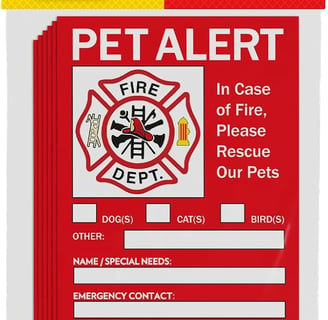Creating an Emergency Plan for Your Dog: How to Get Out Safely and Quickly
8 min read


Understanding the Importance of an Emergency Plan
Creating an emergency plan for your dog is a crucial step for any pet owner, as unforeseen disasters can strike at any moment. Whether it’s a natural calamity such as a hurricane, earthquake, or flood, or even a man-made emergency like a fire, being unprepared can lead to chaos and panic. An emergency plan tailored for your pet can significantly mitigate the risks associated with these events. By anticipating potential crises, you set forth a comprehensive strategy that ensures the well-being and safety of your dog, while also easing your own anxiety during stressful situations.
A major aspect of this preparation involves recognizing that dogs often react to emergencies differently than humans. In the midst of a chaotic situation, your pet may become frightened and disoriented, making it more difficult to ensure their safety. Without a proper plan in place, the likelihood of losing your dog or suffering injuries increases dramatically. Hence, familiarizing your dog with evacuation procedures and creating a designated 'go-bag' with essential supplies can ease the transition during an emergency.
Additionally, having an emergency plan can save time when every second counts. In a crisis, panic can lead to disorganization and confusion, making it easy to overlook vital information that can help keep your pet safe. By having a well-structured plan, you can quickly execute your actions without having to think through your decisions under duress. Regularly practicing your emergency plan helps not only reinforce your strategy but also enables your dog to adjust to handling various scenarios comfortably.
Ultimately, neglecting to devise an emergency plan for your dog can have dire consequences. Prioritizing safety and preparation enhances your ability to respond effectively, ensuring that both you and your dog can navigate through any catastrophe together, fostering a sense of security amidst uncertainty.
Assessing Risks: What Emergencies Should You Prepare For?
When creating an effective emergency plan for your dog, it is essential first to assess the various risks that could necessitate a swift departure from your home. Emergencies can arise in various forms, including natural disasters, medical emergencies, or unforeseen circumstances, and being prepared can significantly enhance your safety and the welfare of your pet.
Natural disasters are the most prominent category of emergencies that pet owners should consider. Depending on your geographical location, you may face specific threats such as wildfires, hurricanes, floods, or earthquakes. Each of these situations demands a unique response, and it is vital to understand how they could affect you and your dog. For instance, if you live in an area prone to floods, having an evacuation route and a designated safe location for your dog should be part of your emergency strategy.
Medical emergencies are another crucial factor to address. Sudden health issues, such as an injury or illness, can necessitate immediate action. Being prepared to handle such incidents requires knowing the nearest veterinary clinics and having a basic first-aid kit tailored to your dog's needs. Familiarizing yourself with potential signs of distress in your canine companion can also help in managing their health effectively during a crisis.
Additionally, unforeseen circumstances such as fire, severe weather warnings, or community emergencies should not be overlooked. Assessing your living situation can help identify risks specific to your surroundings, thereby allowing you to create an emergency plan that includes evacuation routes, safe areas, and supplies essential for both you and your dog. By thoroughly evaluating the potential emergencies in your environment, you can develop a comprehensive plan that ensures your pet's safety during a crisis.
Creating Your Pet Evacuation Kit
When preparing for emergencies, having a well-stocked pet evacuation kit for your dog is crucial. This kit should be assembled in advance and kept in an easily accessible location to ensure a swift response in case of an emergency. A comprehensive pet evacuation kit typically includes several essential items that cater to your dog's basic needs, comfort, and safety.
First and foremost, ensure you have enough food and water to last at least several days. Pack high-quality, non-perishable dog food in sufficient quantities, as well as clean drinking water in durable containers. It is advisable to include a portable bowl for feeding and hydration on the go. In addition to food and water, do not forget to pack medications that your dog may require, along with any relevant veterinary records, especially vaccination documents, in case you need to consult a veterinarian.
Comfort items are also essential for reducing your dog's anxiety during a stressful situation. Including familiar toys, a blanket, or a favorite bed can provide a sense of security for your pet. Furthermore, consider adding a leash, a muzzle, and an identification tag with your contact information to help keep your dog secure and easily identifiable should you become separated. Additionally, having a portable crate or pet carrier can ensure your dog’s safety during transport.
Lastly, ensure that your pet evacuation kit is regularly checked and updated as necessary. Monitoring the expiration dates of food, medications, and other supplies will guarantee that all items remain effective and safe for your pet. By taking these precautionary steps and creating a well-thought-out pet evacuation kit, you are setting your dog up for the best possible outcome during emergencies.
Training Your Dog for Emergency Situations
Training your dog to remain calm and obedient during emergencies is crucial for ensuring their safety and yours. An emergency can evoke fear and anxiety in dogs, which is why desensitizing them to stressful situations is essential. Start by exposing your dog to controlled, unfamiliar environments, such as new parks or busy streets. Gradually introducing your dog to various stimuli helps them adapt to the unpredictability that can occur during an emergency.
One effective method to train your dog is through consistent command practice. Teach basic commands, such as "sit," "stay," "come," and "leave it." These commands establish a foundation of obedience and help maintain control during critical situations. Using positive reinforcement, such as treats and praise, can positively reinforce desired behaviors. Practicing these commands regularly ensures that your dog responds promptly, even amidst distractions.
Incorporating evacuation drills into your routine is another essential element of emergency training. Conduct simulated evacuations where you practice the process of gathering necessary supplies and leaving your home with your dog. Make this exercise as realistic as possible by including elements such as loud noises or sudden movements. This will help your dog associate the act of evacuating with a safe and manageable experience. Repeat these drills periodically, allowing your dog to become familiar with the routine and expectations.
Additionally, consider utilizing a designated “safe spot” within your home. This could be a specific room or area where your dog feels secure. Training your dog to go to this space during an emergency can provide comfort and a sense of safety amidst chaos. Building a consistent behavior pattern around this safe zone can enhance their willingness to comply during real emergencies.
By integrating these training methods into your dog’s routine, you prepare them for emergencies and create a stronger bond based on trust and understanding. Consistent practice will enhance your dog's ability to manage stressful situations and improve your overall emergency preparedness.
Identifying Safe Places for You and Your Dog
In the unfortunate event of an emergency, having a predetermined plan regarding safe locations to take your dog is of utmost importance. Various options are available depending on your community and personal connections. Identifying these safe spots in advance can alleviate stress and facilitate a smoother evacuation process when time is of the essence.
One viable option is the homes of trusted friends or family members. Establishing a relationship with these individuals ahead of time ensures they are willing to take in your dog during a crisis. It is prudent to discuss this with them, providing an overview of your dog's needs, behavior, and any specific requirements they may have. Having a roster of such contacts can save valuable time during an emergency.
Local animal shelters should also be considered. Many shelters have contingency plans for emergencies and can serve as a temporary refuge for your pet. Before relying on this option, it is advisable to visit the shelter, familiarize yourself with their facilities, and inquire about their policies regarding emergency situations. Knowing their capacity for accommodating pets is essential, as some shelters may have limited space or resources during crises.
Pet-friendly hotels represent another alternative. Conducting research on nearby hotels that welcome pets can save you time in an emergency. Be sure to read their policies regarding pet accommodation and any associated fees. It's also helpful to contact them beforehand to confirm availability and inquire about their emergency protocols.
Preparing a list of these safe spaces and their respective contact information can streamline your emergency response. Having this information readily accessible ensures that you can quickly relocate, keeping both you and your dog safe during unforeseen circumstances.
Establishing a Communication Line with Your Pet Care Network
Creating an effective communication plan with your pet care network is an essential part of your emergency plan for your dog. This network may include pet sitters, close friends, family members, and even neighbors who are willing to assist you in an urgent situation. By having a defined communication strategy, you ensure that everyone understands their roles and responsibilities, which can help alleviate stress during unexpected circumstances.
First, it is important to identify key individuals who can step in to help care for your dog if you are not available. This could be a trusted friend or family member who is familiar with your pet's needs, routines, and behavior. Once you have identified these individuals, arrange a meeting to discuss your emergency plan. Explain your dog's specific needs, including dietary restrictions, health issues, and any behavioral quirks that may be important for caregivers to know. This way, they will feel more confident in their ability to assist you.
Next, establish a communication method to relay important information quickly. Consider creating a group chat, email thread, or dedicated messaging platform that includes all members of your pet care network. In this digital space, share vital information such as veterinary contacts, your dog's medical history, and emergency care instructions. Regular updates should also be provided to keep everyone informed about any changes in your pet’s routine or care requirements.
In events when immediate action must be taken, ensure that pet sitters or other caregivers know how to reach you. Provide them with a copy of your emergency plan, including evacuation routes and alternate contact numbers, so they can act swiftly on your behalf. By fostering open lines of communication and ensuring everyone knows their role, you can successfully navigate any emergencies with your dog's well-being as the top priority.
Reviewing and Practicing Your Emergency Plan Regularly
Creating an effective emergency plan for your dog is an ongoing commitment that extends beyond initial setup. Regular reviews and practice of this plan ensure that you and your canine companion remain prepared in the event of an unforeseen situation. It is essential to establish timelines for these reviews; doing so can reinforce your readiness and help your household stay engaged with the outlined procedures. Consider conducting a comprehensive review of your emergency plan at least twice a year, while also incorporating spontaneous drills to simulate real-life scenarios.
When revising your emergency plan, take into account any changes in your dog's health, behavior, or living situation. For instance, if your dog has developed a medical condition, your plan may need to include considerations for additional medical supplies or adjustments to your evacuation routes based on accessibility for older or ailing dogs. This adaptability keeps your plan relevant and effective in any situation.
Moreover, practicing evacuation drills can help familiarize both you and your dog with the necessary actions to take during an emergency. These drills can reduce panic and confusion, which are critical during high-stress situations. Involve all family members in these practices to ensure everyone understands their roles and responsibilities. Utilizing treats, toys, and positive reinforcement can help make these drills enjoyable for your dog, turning a potentially stressful situation into positive experiences for both of you.
Lastly, it is crucial to stay informed about any local risks that may necessitate revising your emergency plan. Updating your plan as circumstances change—whether due to new threats (like natural disasters) or alterations in your dog's needs—demonstrates proactive ownership and commitment to your pet's safety. Maintaining and practicing an effective emergency plan is an essential component of responsible dog ownership.











